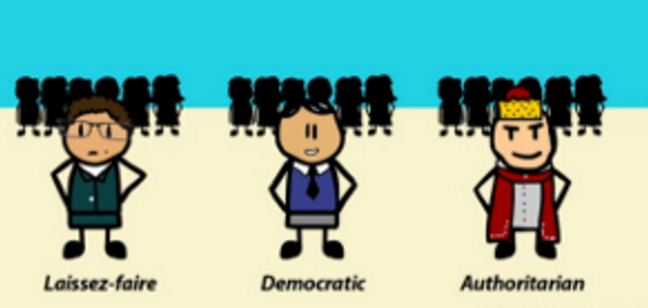A leader is best when people barely know he exists, when his work is done, his aim fulfilled, they will say: we did it ourselves. —Lao Tzu
The most dangerous leadership myth is that leaders are born-that there is a genetic factor to leadership. That’s nonsense; in fact, the opposite is true. Leaders are made rather than born. —Warren Bennis
Effective leadership is putting first things first. Effective management is discipline, carrying it out. —Stephen Covey
(Forbes. 2012)
Now businesses have started using various different styles of Leadership to manage their operations and produce good results. If a leader tries to understand these leadership styles and execute them properly in the business, then one can surely become an effective leader.
MANAGEMENT vs LEADERSHIP
David Brent, a master of Management Talk said “Leadership and Management were once just a topic for Television sitcoms.” 
Management is a set of process that makes a company or an organisation function. This process basically includes planning, staffing, budgeting, measuring performance and problem solving when the results are not according to the plan (Ratcliffe. 2013).
Leadership is very different from management. It is more about putting across the vision to the people, that means more motivation, inspiration and communication (Ratcliffe. 2013).
| BASE | MANAGEMENT | LEADERSHIP |
| Vision | -Planning & Budgeting
-Sets timelines -Impersonal attitude towards goal & vision |
-Developing the vision
-Strategy to achieve the vision -Passionate attitude towards the goal & vision |
| Human Development / Networking | -Organizing & staffing
-Maintaining the structure -Delegating the authority -Delegating the responsibility -Implementing the vision -Low emotions -Less employee choices |
-Aligning the organization
-Communicating vision & vision -Displaying more drive -High emotions -More increases choices for employees |
| Vision execution | -Controlling the process
-Identifying the problems -Solving the problems -Monitoring the results -Takes less risks |
-Motivating & inspires
-Overcoming the barriers to change -Fulfills basic human needs -High risks involved for problem solving
|
| Outcome | -Providing expected results & being consistent
|
-Promoting dynamic changes in order to improve the approach
|
Styles of Leadership
in 1939, Kurt Lewin came up with this framework on leadership styles. He and his team researched on the process and decision making and gave us three different styles of leadership which are Autocratic, Democratic and Laissez – Faire.

Autocratic: These leaders usually make decisions without discussing with team members, even if the input would be beneficial. In this leader tells his or her staff what and how to do things without knowing their take on it. Therefore, it sometimes can be demoralising and demotivating for the employees.
Democratic: Leaders makes the final call on any subject but they however involve team members in the whole process. They promote creativity and innovation. This decision making process involves more than one person. And because of this the employees usually have a better job satisfaction and higher productivity.
Laissez – Faire: In this leaders leave their employees free and welcome all kinds of ideas and suggestions from them. Employees enjoy a lot of freedom in how they work. They support their arguments with related resources and evidences. This leads to extreme job satisfaction. However, this sometimes can backfire if the any team member don’t manage their time accordingly and end up exceeding the deadline.
MOST EFFECTIVE STYLE
One can never say as to which style is best and why. There is no perfect approach. However, as far as I am concerned, I would like to work under a mixture of both democratic and laissez – faire because I work my best when I Know what I need to do but how I do that should be under my control. Sir Richard Branson would be just apt for me as he gives his employer that freedom and space where they can improve and grow as an individuals.

Understanding the frameworks and theories is important as you can use them in your practical life and try to be a better leader. However, I strongly believe its equally important to know about all the styles and the advantages & disadvantages of each. A good leader will try to use all styles of leadership with one of them being dominant. Usually leaders who stick with just one style turn out to be the bad ones.
References
Kevin Kruse (2012) Forbes [online] available from <http://www.forbes.com/sites/kevinkruse/2012/10/16/quotes-on-leadership/#4f79c5d47106; [10 March 2016]
Rebecca Ratcliffe (2013) The guardian [online] available from <http://www.theguardian.com/careers/difference-between-leadership-management; [10 march 2016]
Anon. (2016). [online] available from <http://timabareblog.com/my-leadership-style; [10 March 2016].

The table summed up the entire blog post. However I disagree with you about the most effective style; according to me the democratic style would be the most efficient. What are your views about this?
LikeLike
Thanks for the comment Areeba!
and as far as the most efficient style of leadership is concerned, this is just my opinion and the best approach that I feel will be good for me.
Hope that clears it!
LikeLike
Great work Sohaib! I appreciate the way you write and deliver the theme. It is very important to know the difference between a leader and a manager. Roles for both are interconnected but different. Liked the last part of the blog about most effective leadership . No doubts on Richard Branson be the best of all. Good Luck!
LikeLike
Thanks for your comment!
Yes, the difference between a leader and a manager is very minimal but essential in the real nature.
LikeLike
You presented a very detailed leadership style insight. Highly recommended reading for leadership students.
LikeLike
OH! THANKS MATE 😀
I really feel motivated to write some more posts now. Now that makes you a good Leader 🙂
LikeLike
I totally agree with the Warren Bennis’s quote that you included. And the video was interactive as well.
Also, the tabular comparison of Leadership & Mgt. really summed it up for me.
Thumbs up!
LikeLike
The whole idea of the video was just to enlighten readers more on the topic.
And that table wasn’t easy to make but I am happy i pulled it off. Thanks again!
LikeLike